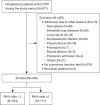The clinical characteristics associated with the ratio between the main pulmonary artery and ascending aorta diameter in patients with acute exacerbation of chronic obstructive pulmonary disease
- PMID: 39268104
- PMCID: PMC11388226
- DOI: 10.21037/jtd-24-62
The clinical characteristics associated with the ratio between the main pulmonary artery and ascending aorta diameter in patients with acute exacerbation of chronic obstructive pulmonary disease
Abstract
Background: A pulmonary artery-to-aorta (PA/A) ratio of ≥1 is a reliable indicator of pulmonary hypertension and is associated with an increased risk of acute exacerbation of chronic obstructive pulmonary disease (COPD) and long-term mortality in patients with stable COPD. However, it is unclear whether a PA/A ratio of ≥1 is associated with mortality in patients hospitalized with acute exacerbation of COPD. The purpose of this study was to evaluate the clinical course and mortality of patients with PA/A ratios of ≥1 who were hospitalized with acute exacerbation of COPD.
Methods: We retrospectively reviewed the medical charts of patients admitted to a tertiary referral hospital and a secondary hospital with acute exacerbation of COPD between 2016 and 2021. Chest computed tomography was used to measure the pulmonary artery (PA), aorta (A) diameter, and the PA/A ratio. The study involved 324 and 111 patients with PA/A ratios <1 and ≥1, respectively.
Results: The average age in the two groups was 74.1 and 74.5 years, which was not significantly different. When compared with the group with PA/A ratios of <1, the group with PA/A ratios of ≥1 had a lower proportion of males (71.2% vs. 89.5%, P<0.001), more patients with type 2 respiratory failure (35.1% vs. 18.8%), higher high-flow nasal cannula use (10.8% vs. 4.6%), higher use of non-invasive ventilation (NIV) (21.6% vs. 7.7%), and longer hospital stay (10.9 vs. 9.5 days). In-hospital mortality was not significantly different between the two groups. A PA/A ratio of ≥1 was identified as an independent predictor of the need for high-flow nasal cannula, NIV, and intubation in COPD patients.
Conclusions: Patients with PA/A ratios of ≥1 had a high incidence of type 2 acute respiratory failure and required advanced treatment, including high-flow nasal cannula, NIV, and intubation. Therefore, hospitalized patients with acute exacerbation of COPD and PA/A ratios of ≥1 require more aggressive treatment.
Keywords: Chronic obstructive pulmonary disease (COPD); acute exacerbation; pulmonary artery-to-aorta ratio (PA/A ratio).
2024 Journal of Thoracic Disease. All rights reserved.
Conflict of interest statement
Conflicts of Interest: All authors have completed the ICMJE uniform disclosure form (available at https://jtd.amegroups.com/article/view/10.21037/jtd-24-62/coif). The authors have no conflicts of interest to declare.
Figures



References
LinkOut - more resources
Full Text Sources
